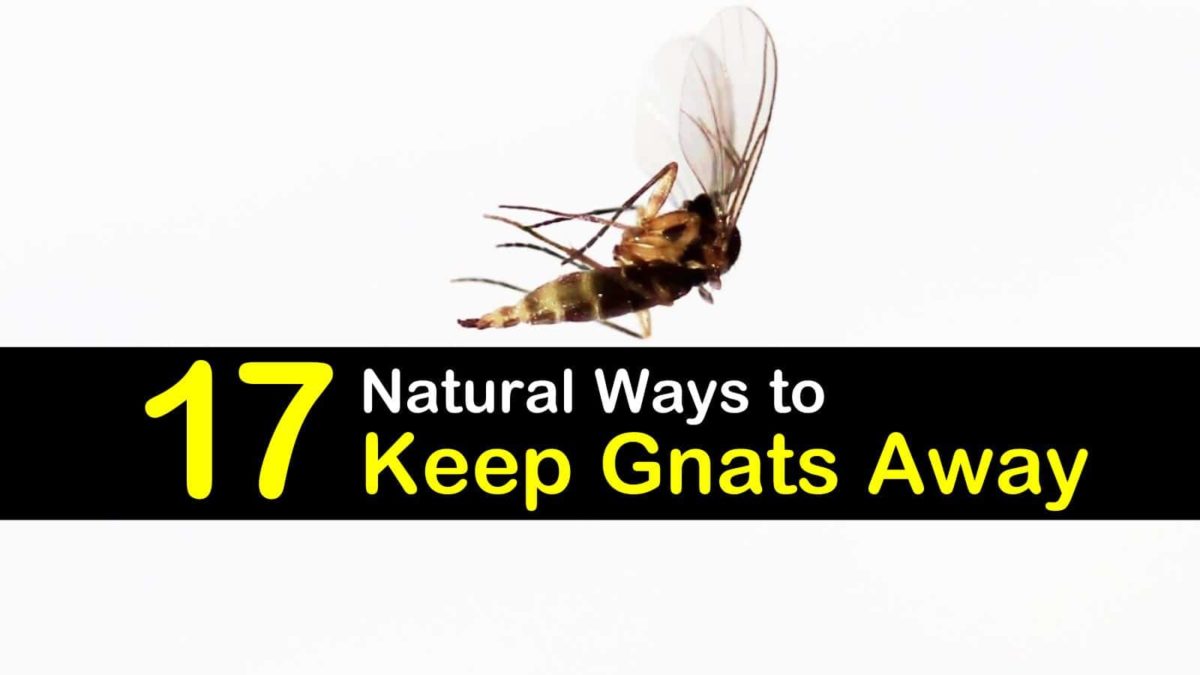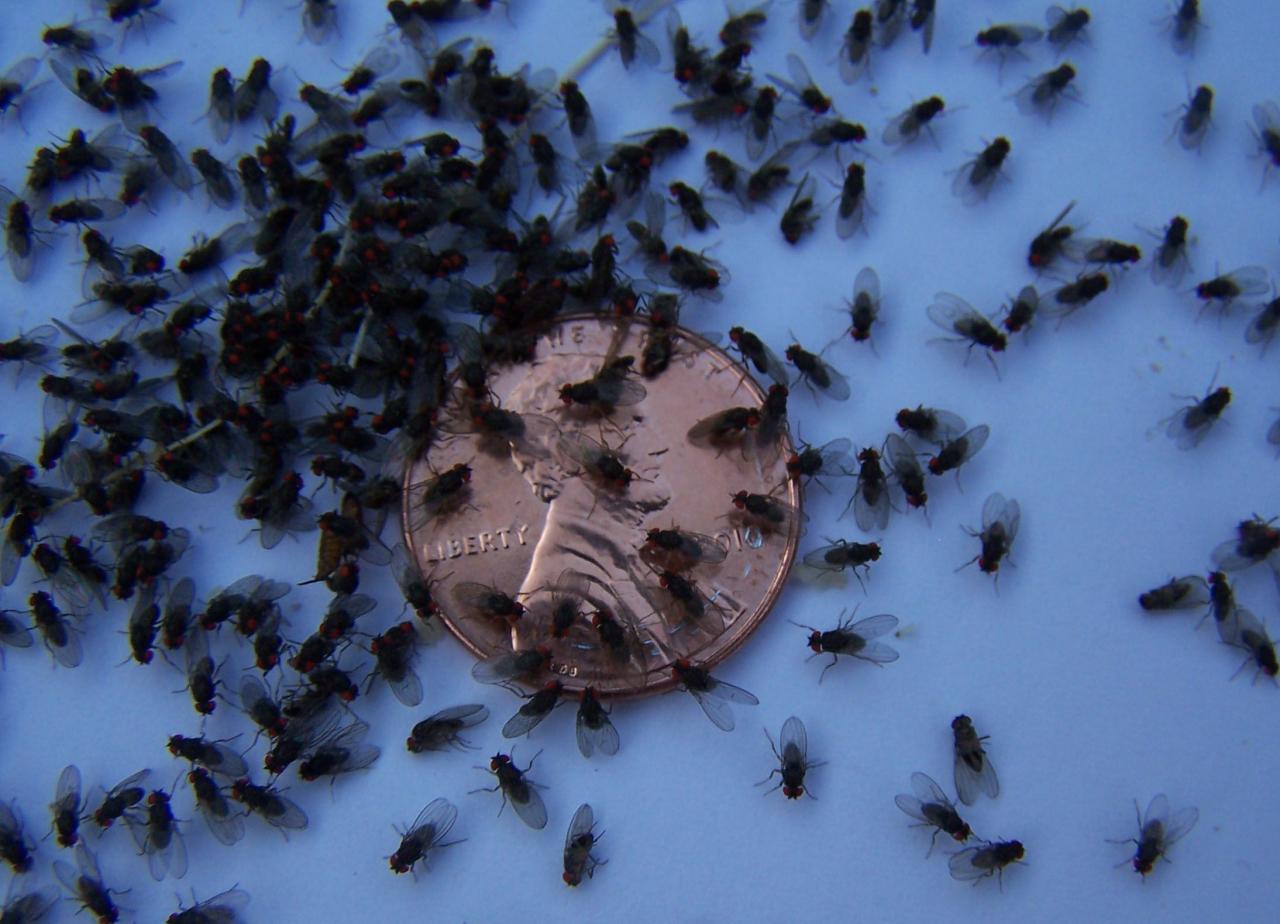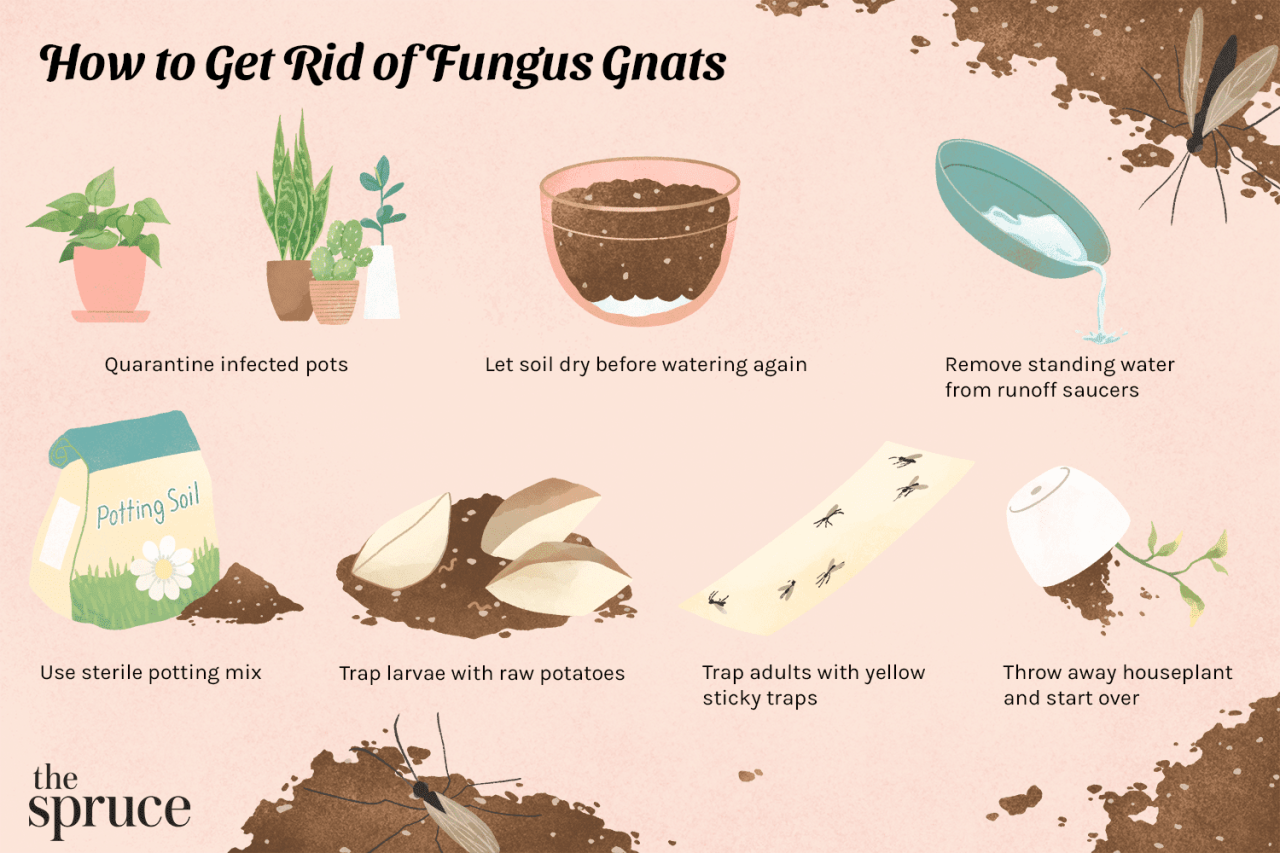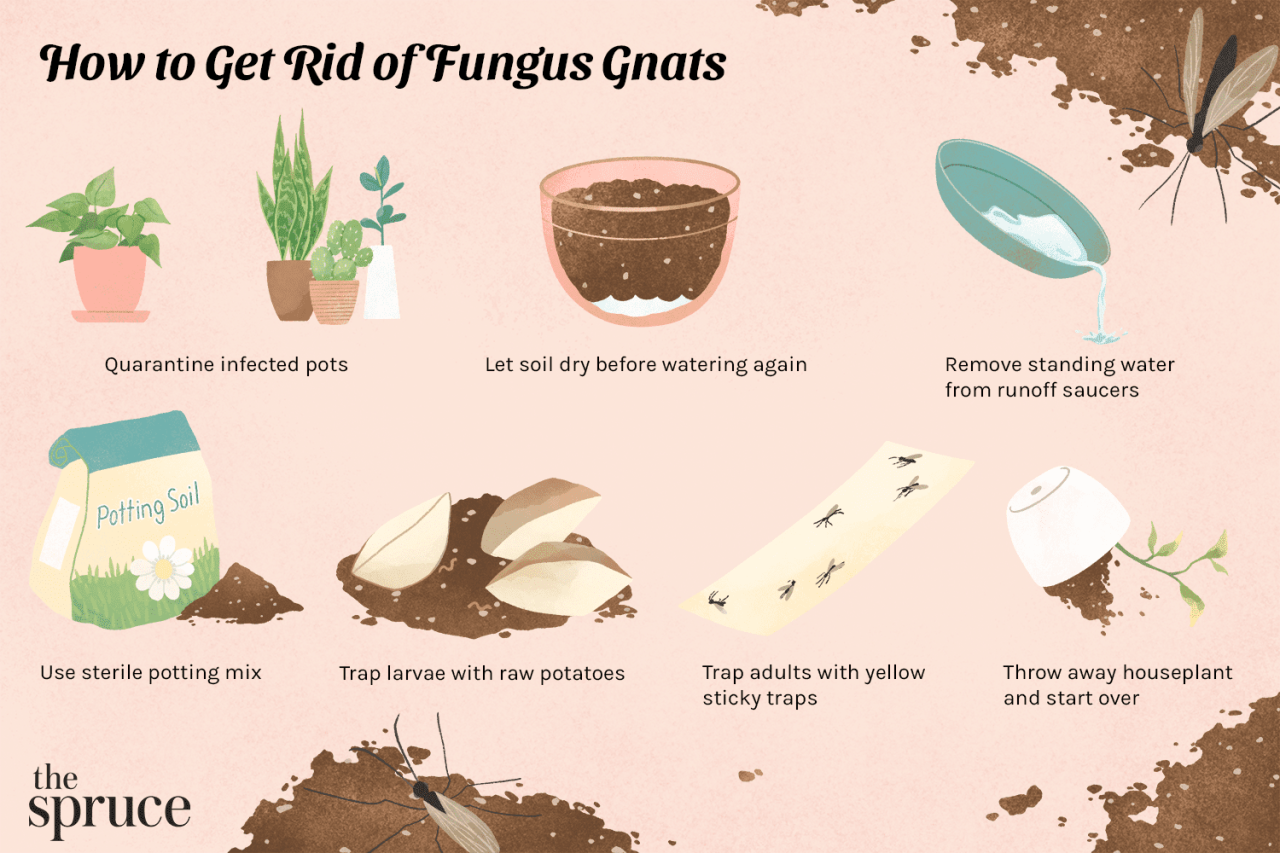How to Keep Gnats Away from Hanging Plants: A common dilemma for plant enthusiasts, gnats can quickly turn a beautiful hanging garden into a frustrating nuisance. These tiny flies are attracted to the moisture and decaying matter often found in potting soil, and their presence can quickly become a problem.
Understanding the life cycle of gnats and the factors that attract them is crucial to developing an effective plan for keeping them at bay.
This guide will provide a comprehensive approach to preventing and eliminating gnat infestations, covering everything from choosing the right plants to employing natural repellents and chemical treatments. We’ll also explore effective maintenance practices and provide practical solutions for common gnat problems.
Understanding Gnats and Their Attraction to Hanging Plants

Gnats are small, flying insects that can be a nuisance in homes and gardens, especially around hanging plants. They are often attracted to the moist environment and decaying matter that can accumulate in these plants. Understanding the types of gnats, their life cycle, and what attracts them to hanging plants can help you take steps to prevent them from becoming a problem.
Types of Gnats Commonly Found Around Hanging Plants
There are several types of gnats that are commonly found around hanging plants. Some of the most common include:
- Fungus gnats: These gnats are small, dark-colored insects with long legs. They are attracted to moist soil and decaying organic matter, such as dead leaves and roots. Fungus gnats are often found in potting soil, especially if it is too wet.
- Fruit flies: These gnats are also known as vinegar flies. They are attracted to ripe or overripe fruit, as well as decaying organic matter. They are often found in kitchens and bathrooms, but can also be attracted to hanging plants if there is fruit or decaying matter nearby.
- Shore flies: These gnats are attracted to moist environments, such as damp soil and decaying matter. They are often found around hanging plants, especially if the soil is too wet. Shore flies are also attracted to garbage and sewage, so it is important to keep these areas clean.
Factors That Attract Gnats to Hanging Plants
Gnats are attracted to hanging plants for several reasons, including:
- Moisture: Gnats are attracted to moist environments. Hanging plants are often watered frequently, which can create a moist environment that is ideal for gnats to breed.
- Decaying matter: Gnats are attracted to decaying organic matter, such as dead leaves, roots, and fruit. This decaying matter provides a food source for gnats and their larvae.
- Food sources: Gnats are also attracted to food sources, such as overripe fruit and sugary substances. If you have any fruit or sugary substances near your hanging plants, gnats may be attracted to them.
Life Cycle of Gnats
Gnats have a short life cycle that can be divided into four stages:
- Egg: Gnats lay their eggs in moist environments, such as soil, decaying matter, or even on the surface of water.
- Larva: After hatching, gnat larvae feed on decaying matter and grow rapidly.
- Pupa: When the larvae are fully grown, they form a pupa. The pupa is a hard, inactive stage where the gnat undergoes metamorphosis.
- Adult: After a few days or weeks, the adult gnat emerges from the pupa. Adult gnats are short-lived, but they can lay hundreds of eggs, which start the cycle again.
Preventive Measures

Preventing gnat infestations in your hanging plants requires a multi-pronged approach, focusing on plant selection, proper watering techniques, and soil quality. By understanding the factors that attract gnats and implementing these preventive measures, you can significantly reduce the risk of encountering these pesky insects.
Keeping gnats away from hanging plants starts with understanding their source: fungus gnats. These pesky insects thrive in moist, decaying matter, often found in the soil of potted plants. To effectively combat them, you’ll need to address the root of the problem, so to speak.
Effective Methods for Getting Rid of Fungus Gnats in Plants provide a comprehensive guide to eliminating these pests. Once you’ve addressed the fungus gnat issue, you can focus on preventing them from returning by ensuring proper drainage and avoiding overwatering, particularly in your hanging plants.
Choosing Gnat-Resistant Plants
Selecting plants that are naturally less attractive to gnats can be a proactive step in preventing infestations. Certain plant species have characteristics that make them less hospitable to gnats, such as:
- Succulents:These plants thrive in dry conditions, which are unfavorable for gnats. Examples include Echeveria, Sedum, and Haworthia.
- Cacti:Similar to succulents, cacti prefer arid environments and are generally resistant to gnats.
- Herbs:Many herbs, such as rosemary, lavender, and thyme, produce aromatic oils that can deter gnats.
Proper Watering Techniques
Gnats are drawn to moist environments, so controlling the amount of water your plants receive is crucial. Overwatering is a primary culprit in gnat infestations, as it creates the perfect breeding ground for these insects. Here are some tips for proper watering:
- Allow the soil to dry slightly between waterings:This ensures that the soil doesn’t become overly saturated, discouraging gnat activity.
- Water thoroughly but infrequently:Deep watering allows the roots to absorb moisture effectively, reducing the likelihood of excess moisture in the soil surface.
- Avoid overhead watering:Overhead watering can create puddles on the soil surface, attracting gnats. Water directly at the base of the plant instead.
Soil Quality and Drainage
The type of soil you use for your hanging plants can significantly impact gnat infestations. Poor drainage can lead to waterlogged soil, creating a favorable environment for gnats.
- Choose well-draining soil:Use a potting mix specifically designed for hanging plants, as these mixes are formulated for optimal drainage. Look for ingredients like perlite or vermiculite, which help aerate the soil and improve drainage.
- Avoid compacting the soil:Ensure the soil is loose and airy to allow for proper drainage. Avoid over-packing the soil in the pot, which can hinder water flow.
- Use a pot with drainage holes:This is essential to prevent water from accumulating at the bottom of the pot. Ensure that the drainage holes are not blocked by debris or roots.
Natural Repellents and Solutions
While preventative measures are crucial, natural repellents and solutions can be effective in deterring gnats from your hanging plants. These methods utilize the power of nature to create a less hospitable environment for these pesky insects.
Essential Oils
Essential oils offer a natural and aromatic way to repel gnats. Certain scents, such as peppermint, lavender, tea tree, and lemongrass, are known to deter these insects. To use essential oils effectively, you can create a spray by mixing a few drops of your chosen oil with water in a spray bottle.
Apply this solution to the leaves of your plants and the surrounding area.
Note: Be cautious when using essential oils around pets and young children.
Garlic
Garlic’s pungent aroma is another natural deterrent for gnats. You can plant garlic near your hanging plants or create a garlic spray by crushing a few cloves of garlic and steeping them in water for a few hours. Strain the mixture and spray it on your plants.
Peppermint
Peppermint, like garlic, has a strong scent that repels gnats. You can grow peppermint plants near your hanging plants or create a peppermint spray by mixing peppermint oil with water.
DIY Traps, How to Keep Gnats Away from Hanging Plants
Creating DIY traps is an effective way to catch and eliminate gnats.
Vinegar Traps
Vinegar’s pungent smell attracts gnats. To create a vinegar trap, fill a small bowl or jar with apple cider vinegar. Add a few drops of dish soap to break the surface tension of the vinegar, preventing the gnats from escaping.
Place the trap near your hanging plants.
Yellow Sticky Traps
Gnats are attracted to yellow, making yellow sticky traps an effective solution. You can purchase these traps online or at garden centers. Alternatively, you can create your own by coating yellow paper or cardboard with a sticky substance like petroleum jelly or honey.
Beneficial Insects
Introducing beneficial insects like ladybugs and lacewings can help control gnat populations naturally. These insects prey on gnat larvae, reducing their numbers and preventing further infestations. You can purchase beneficial insects online or at garden centers.
While keeping gnats away from hanging plants can be a challenge, understanding their popularity helps us appreciate the importance of finding solutions. Hanging plants have been a staple in homes and gardens for centuries, dating back to ancient civilizations who utilized their aesthetic appeal and practicality.
The History of Hanging Plants and Their Popularity explains how these vertical gardens have evolved throughout history. Whether it’s a modern minimalist design or a traditional Victorian setting, keeping these beloved plants gnat-free ensures their continued beauty and enjoyment.
Chemical Treatments

Chemical treatments are a last resort when dealing with gnats in hanging plants. While effective, they come with safety considerations and potential risks. This section will discuss commercially available gnat repellents and insecticides, the safety considerations, and how to apply them effectively and safely.
Types of Chemical Treatments
Commercially available gnat repellents and insecticides come in various forms, each with its strengths and weaknesses. These include:
- Sprays:These are typically applied directly to the soil or plants, and they often contain pyrethroids or neonicotinoids. They offer a quick and easy way to kill gnats, but they can also be harmful to beneficial insects and pets.
- Granules:These are applied to the soil and release chemicals slowly over time. They can be effective in controlling gnats but can also be harmful to beneficial insects and pets.
- Liquid concentrates:These are diluted with water and then applied to the soil or plants. They are generally more concentrated than sprays and granules, but they can also be more harmful to beneficial insects and pets.
- Yellow sticky traps:These traps attract gnats with their bright yellow color and are often used to monitor gnat populations. They are not a direct insecticide but can help to reduce gnat numbers.
Safety Considerations and Potential Risks
Chemical treatments can pose risks to humans, pets, and the environment. It’s essential to use them cautiously and follow the manufacturer’s instructions carefully.
- Toxicity to humans and pets:Many chemical treatments contain ingredients that can be toxic to humans and pets. Always wear gloves and a mask when applying chemical treatments, and keep children and pets away from the treated area.
- Environmental impact:Some chemical treatments can harm beneficial insects, such as bees and ladybugs, and can also pollute water sources. It’s important to choose environmentally friendly options whenever possible.
- Resistance:Over time, gnats can develop resistance to certain chemicals, making them less effective. This can lead to a cycle of using stronger chemicals, which can have negative consequences.
Applying Chemical Treatments Effectively and Safely
To maximize the effectiveness and minimize the risks of chemical treatments, follow these steps:
- Identify the type of gnat:Different types of gnats respond to different chemicals. If possible, identify the type of gnat you are dealing with before applying any treatment.
- Read the label carefully:Always read and follow the manufacturer’s instructions on the label. This includes the application rate, frequency, and safety precautions.
- Apply in the evening:Applying chemical treatments in the evening when the gnats are less active can reduce the risk of harming beneficial insects.
- Avoid over-application:Over-applying chemical treatments can be harmful to plants and the environment. Only apply the amount recommended on the label.
- Monitor the results:Monitor the results of the treatment and adjust your approach if necessary.
Summary
By following the preventative measures, natural solutions, and maintenance tips Artikeld in this guide, you can effectively deter gnats from your hanging plants and enjoy a thriving, pest-free garden. Remember, a proactive approach is key to preventing gnat infestations, so stay vigilant and don’t hesitate to implement solutions as needed.
With a little effort and the right strategies, you can ensure your hanging plants remain a beautiful and enjoyable part of your home.
FAQ: How To Keep Gnats Away From Hanging Plants
What are the best types of plants to choose for hanging baskets to minimize gnat problems?
Opt for plants that are naturally more resistant to gnats, such as succulents, cacti, or herbs like rosemary and lavender. These plants tend to have less moisture in their leaves and soil, making them less appealing to gnats.
Can I use mosquito netting to keep gnats away from my hanging plants?
While mosquito netting can help prevent larger insects from accessing your plants, it’s unlikely to effectively deter gnats. Their small size allows them to easily pass through the netting.
How often should I inspect my hanging plants for signs of gnats?
Regularly inspect your hanging plants, at least once a week, for signs of gnats, such as small flies hovering around the soil or tiny white larvae. Early detection is crucial for controlling infestations before they become severe.
